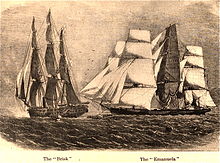This article needs additional citations for verification. (July 2023) |
| Blockade of Africa | |||||||
|---|---|---|---|---|---|---|---|
| Part of Suppression of the African slave trade | |||||||
 HMS Brisk capturing the Spanish slave ship Emanuela. | |||||||
| |||||||
| Belligerents | |||||||
| Slave traders | ||||||
| Commanders and leaders | |||||||
| Francisco Félix de Souza | |||||||
| Part of a series on |
| Forced labour and slavery |
|---|
 |
The Blockade of Africa began in 1808 after the United Kingdom outlawed the Atlantic slave trade, making it illegal for British ships to transport slaves. The Royal Navy immediately established a presence off Africa to enforce the ban, called the West Africa Squadron. Although the ban initially applied only to British ships, Britain negotiated treaties with other countries to give the Royal Navy the right to intercept and search their ships for slaves.[1]
The 1807 Act Prohibiting Importation of Slaves abolished the intercontinental slave trade in the United States but was not widely enforced. From 1819, some effort was made by the United States Navy to prevent the slave trade. This mostly consisted of patrols of the shores of the Americas and in the mid-Atlantic, the latter being largely unsuccessful due to the difficulty of intercepting ships mid-ocean. As part of the Webster–Ashburton Treaty of 1842, it was agreed that both countries would work together on the abolition of the slave trade, which was deemed piracy, and to continue the blockade of Africa. US Navy involvement continued until the beginning of the American Civil War, in 1861. The following year, the Lincoln administration gave the UK full authority to intercept US ships. Slavery was not abolished in the United States until 1865, when Congress ratified the 13th Amendment. The Royal Navy squadron remained in operation until 1870.
- ^ Falola, Toyin; Warnock, Amanda (2007). Encyclopedia of the middle passage. Greenwood Press. pp. xxi, xxxiii–xxxiv. ISBN 9780313334801.